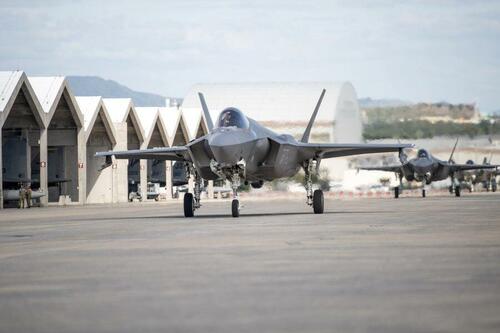US Air Force Explores Strategic Overhaul In Pacific To Counter Rising China Challenge
Authored by Stephen Xia and Sean Tseng via The Epoch Times (emphasis ours),
The U.S. Air Force is considering revamping its operations in the Pacific to address increasing challenges from communist China. Rather than focusing solely on expensive fighter jets, it is shifting toward cost-effective technologies such as drones and hypersonic missiles and adopting dispersed operational tactics to maintain an advantage.

A recent report from the U.S. Air Force’s China Aerospace Studies Institute highlights the need to update equipment priorities to counter China’s military expansion. Lessons from the Russia–Ukraine war have shown that modern conflicts consume resources rapidly, making reliance on a limited number of costly weapons impractical. To prepare for prolonged engagements, developing advanced yet affordable weapons is crucial.
Long-range precision strikes and the use of drones have emerged as game-changers, allowing forces to remain effective while avoiding heavy enemy fire. Dispersed operational tactics have also proven advantageous, helping forces preserve strength and counterattack effectively. With these insights, the U.S. Air Force is preparing for potential conflicts in the Indo-Pacific, which could be more extensive and intense than the Russia–Ukraine war.
China seeks to alter the global power balance and push U.S. forces out of the Indo-Pacific using anti-access/area-denial (A2/AD) strategies. These involve the use of missiles, aircraft, and naval defenses to block access, making it costly or difficult for opponents to access contested regions.
To counter this, the Air Force think tank recommends focusing on inexpensive, easily replaceable weapons capable of penetrating defenses, such as low-cost drones and hypersonic missiles. While advanced aircraft such as the B-21 bomber and next-generation fighter jets remain important, there is increasing emphasis on survivable, high-tech weapons and expendable platforms.
Air Base Defense
A significant concern is the vulnerability of U.S. air bases in the region, particularly in Japan, which Chinese missiles, drones, and hypersonic weapons could target. The Department of Defense (DOD) noted in its 2023 China Military Power Report that the People’s Liberation Army has consistently expanded its long- and mid-range ballistic missile capacity, enabling it to target critical U.S. military installations throughout the Indo-Pacific, including key bases on Guam.
Additionally, the DOD estimates that as of May 2023, Beijing possessed more than 500 operational nuclear warheads, with numbers growing. Given China’s expanding missile capabilities, strengthening base defenses alone is insufficient. Therefore, the United States is adopting a new strategy: spreading out deployments to reduce risk.
The U.S. military is repositioning its forces across multiple locations to reduce the risk of being targeted. This strategy involves identifying, upgrading, and restoring airfields throughout the Pacific, including old World War II sites, under an initiative known as Agile Combat Employment. This includes redeveloping airfields like the one on Tinian, a small island near Guam that was a strategic location during World War II.
The airfields in Tinian are being expanded for the first time in decades. By positioning aircraft across a range of bases—including allied bases, remote islands, and civilian runways—the Air Force aims to increase flexibility and survivability.
Michael P. Winkler, the Pacific Air Force’s deputy director for air and cyberspace operations, emphasized the need to avoid putting all aircraft in one place to prevent creating a “big, juicy target” for adversaries. This strategy requires access to more airfields during crises, necessitating coordination with regional allies like Japan and the Philippines.
Operational Resiliency
Securing access agreements with regional allies is crucial, as they are in a position to offer numerous military and civilian runways, although not all meet the Air Force’s requirements. U.S. pilots are visiting potential locations like Basa Air Base in the Philippines and airfields in Tinian, Guam, Saipan, and Palau to familiarize themselves and prepare for future operations. Upgrades are underway at several sites to enhance facilities and train personnel.
While the Second Island Chain, which includes some U.S.-controlled areas, is easier to access and upgrade, the First Island Chain is strategically more important due to its proximity to China. This chain includes Japan, the Philippines, and Taiwan. Operating there requires cooperation with regional partners, whose political situations can be unpredictable. Despite these challenges, the United States currently maintains strong partnerships in the region.
Recent military exercises have tested this dispersed approach. In February, U.S. and allied aircraft operated from multiple airfields on Guam, Saipan, and Tinian. During the U.S.-led Valiant Shield exercises in June, U.S. fighter jets used Japan’s Matsushima and Hachinohe bases for the first time. Under the U.S.–Japan alliance agreement, Japanese bases can serve as evacuation sites for U.S. aircraft in emergencies.
However, spreading out forces presents challenges, particularly in logistics. In a conflict, the United States must deliver equipment, spare parts, fuel, munitions, and support personnel to scattered and potentially contested locations or pre-position supplies there. This is complex, and the strategy’s effectiveness depends on reliable support. The Air Force must balance the benefits of dispersion with logistical practicalities.
On a similar note, Stacie Pettyjohn, a senior fellow at the Center for a New American Security, a Washington-based think tank, said operating from more locations with smaller units reduces the chance of a successful large-scale attack by the Chinese regime, adding a layer of deterrence.
This strategic shift reflects a broader recognition that the nature of warfare is changing. The Air Force is adapting by embracing new technologies and tactics, prioritizing flexibility, resilience, and cost-effectiveness. By dispersing forces and investing in advanced yet affordable weapons, the Air Force aims to maintain its edge in a rapidly evolving security environment.
Views expressed in this article are opinions of the author and do not necessarily reflect the views of The Epoch Times or ZeroHedge.
Tyler Durden
Wed, 11/06/2024 – 18:25

